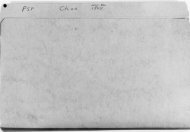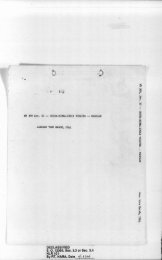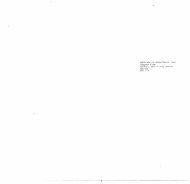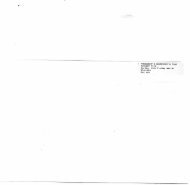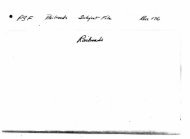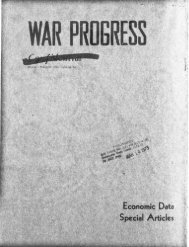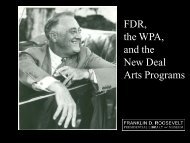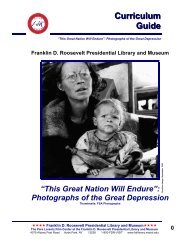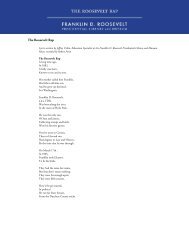FDR's First 100 Days - Franklin D. Roosevelt Presidential Library ...
FDR's First 100 Days - Franklin D. Roosevelt Presidential Library ...
FDR's First 100 Days - Franklin D. Roosevelt Presidential Library ...
Create successful ePaper yourself
Turn your PDF publications into a flip-book with our unique Google optimized e-Paper software.
FRANKLIN D. ROOSEVELT PRESIDENTIAL LIBRARY AND MUSEUM<br />
America, 1933<br />
The dark months before FDR’s inauguration were the bleakest of the Great Depression.<br />
One in four workers was jobless. One in five Americans survived on meager relief<br />
payments. The stock market was down 75 percent from 1929. Exports were at their<br />
lowest level since 1904. In just four years, the suicide rate had tripled.<br />
In rural areas—where almost half of Americans lived— sharply falling crop prices<br />
brought disaster. Farmers defaulted on bank loans and lost their land. Tenant farmers and<br />
sharecroppers faced eviction. Farm laborers’ wages were slashed. Nature added to the<br />
misery. A devastating drought struck the nation’s heartland in the early 1930s. It<br />
triggered enormous dust storms that carried off topsoil and destroyed farmland.<br />
As the nation suffered, its government seemed paralyzed. President Hoover had tried to<br />
combat the Depression, but he believed in limited government and relief through private<br />
charity. Though he eventually approved credit assistance for businesses and some public<br />
construction spending, Hoover was reluctant to fund massive public works projects,<br />
provide federal relief money to the unemployed, or increase government regulation of the<br />
economy. By 1933, he was reviled and exhausted.<br />
On November 8, 1932, Americans elected <strong>Franklin</strong> <strong>Roosevelt</strong> president by a margin of<br />
over seven million votes. <strong>Roosevelt</strong> carried 42 states and voters sent huge Democratic<br />
majorities to Congress. For FDR, the election was a personal triumph and a resounding<br />
mandate for change.<br />
Washington was cold and overcast on Inauguration Day, March 4, 1933.<br />
At the Capitol, FDR braced himself on his son James’s arm as he approached the rostrum<br />
to take the oath of office. Breaking precedent, he recited the entire oath, instead of simply<br />
repeating “I do.” Then, as the crowd grew quiet, he opened his inaugural address.<br />
<strong>Roosevelt</strong> offered Americans reassurance: “This great nation will endure as it has<br />
endured, will revive, and will prosper.” Then, in bold words that reverberate in public<br />
memory, he proclaimed, “. . . the only thing we have to fear is fear itself.”<br />
This now-famous line got little reaction. The greatest applause came when <strong>Roosevelt</strong><br />
declared that if Congress didn’t act, he would ask for “broad Executive power to wage a<br />
war against the emergency. . . .” Americans were ready to grant FDR sweeping power.<br />
As he proclaimed, “This nation asks for action, and action now.”
Photograph, soup kitchen line. Photographer Dorothea Lange took this photograph of<br />
jobless men waiting outside a San Francisco soup kitchen in 1933. From the National<br />
Archives, College Park.
Herbert Hoover to FDR, November 8, 1932. Hoover’s telegram congratulating FDR on<br />
his election victory. <strong>Roosevelt</strong> composed a cordial response on the back. These polite<br />
exchanges mask the tensions that already existed between the two rivals. From the<br />
President’s Secretary’s Files.
The New Yorker magazine cover proof, February 1933. The New Yorker magazine<br />
planned this cover for its March 4, 1933 Inauguration Day issue. But when a would-be<br />
assassin made an attempt on FDR’s life on February 15, the editors decided the Peter<br />
Arno illustration was too lighthearted. Ironically, the artist had predicted the actual scene<br />
inside the presidential limousine as Hoover and <strong>Roosevelt</strong> traveled to Capitol Hill on<br />
Inauguration Day. Museum Object 52.457.
Engraved invitation to inaugural ceremony, 1933. Louis Howe’s invitation to the<br />
inaugural ceremony. Louis Howe was FDR’s closest and longest-serving political<br />
adviser. He began working for <strong>Roosevelt</strong> during FDR’s years in the New York State<br />
Senate. Howe continued advising FDR until his death in 1936. From the Louis McHenry<br />
Howe Personal Papers.
Official Inaugural Program, 1933. On March 4, 1933, FDR was inaugurated as the 32 nd<br />
President of the United States. From the FDR <strong>Library</strong> Inaugural Materials Collection.
Page 1, Reading Copy, <strong>First</strong> Inaugural Address, March 4, 1933. This is the first page of<br />
the reading copy of the Inaugural Address. FDR read from this copy when he delivered<br />
the speech on March 4, 1933. It includes a handwritten change. <strong>Roosevelt</strong> penciled in a<br />
new opening sentence while waiting inside the Senate building for the inaugural<br />
ceremonies to begin. Throughout his Presidency, <strong>Roosevelt</strong> was known for adding lastminute<br />
changes like this to his speeches. From the President’s Master Speech File.
FDR, diary entry, March 5, 1933. At several points in his life, FDR attempted to keep a<br />
diary. These efforts never continued more than a few days. One attempt began when<br />
<strong>Roosevelt</strong> became President. Though it only lasted from March 5-6, 1933, FDR’s diary<br />
entries provide a vivid sense of the drama and activity of his first days in office. The<br />
entry for March 5—<strong>Roosevelt</strong>’s first full day as president—deals almost entirely with the<br />
banking crisis. From the President’s Secretary’s Files.
Summary of Restrictions on Deposit Withdrawals, March 3, 1933. This stark memo with<br />
its accompanying map illustrates the grim state of America’s banking system when FDR<br />
took office. The memo was issued on March 3, the day before FDR’s inauguration. On<br />
March 6, <strong>Roosevelt</strong> closed all the banks in the United States while his administration<br />
drafted emergency banking reform legislation. From the President’s Official File.
continued…
continued…
<strong>Presidential</strong> Proclamation Closing the Nation’s Banks, March 6, 1933. On March 6,<br />
1933, <strong>Roosevelt</strong> issued this dramatic presidential proclamation closing all of the nation’s<br />
banks until banking reform legislation could be enacted. Though it used the term “bank<br />
holiday,” this unprecedented proclamation required the banks to close their doors. The<br />
proclamation closed the banks until March 9, 1933. That date was later extended to<br />
March 13 to give the government time to examine the finances of the banks and<br />
determine which ones were fit to reopen. From the President’s Official File.
<strong>Roosevelt</strong> Garner campaign license plate, 1932. Prohibition repeal was a major plank in<br />
the Democratic Party’s 1932 platform. It was promoted in presidential campaign buttons<br />
and paraphernalia. Museum object 47.93.190.
“Tending Another Tough One,” Fred Seibel, Richmond Times-Dispatch, March 23, 1933.<br />
FDR’s confidence and vitality made a powerful impression on the public. These cartoons<br />
illustrate the perception of him as an exceptionally strong and active leader. This image<br />
became firmly fixed at the very start of his presidency. FDR’s superhuman image<br />
contrasts sharply with the reality of his physical disability. In 1921, <strong>Roosevelt</strong> contracted<br />
infantile paralysis (polio). It left him paralyzed below the waist. During the 1920s, he<br />
waged a heroic battle to strengthen his body, developing the capacity to stand and appear<br />
to “walk” in public. Americans knew the President once had polio, but the degree of his<br />
paralysis was less understood. The press operated under a tacit understanding that FDR<br />
should not be photographed in a wheelchair, being carried, or in other vulnerable<br />
situations. People focused, instead, on <strong>Roosevelt</strong>’s presidential leadership qualities.<br />
From the <strong>Franklin</strong> D. <strong>Roosevelt</strong> <strong>Library</strong> and Museum.
“Looks As If The New Leadership Was Really Going To Lead,” S.J. Ray, Kansas City<br />
Star, March 7, 1933. From the <strong>Franklin</strong> D. <strong>Roosevelt</strong> <strong>Library</strong> and Museum.
Memorandum, Eleanor <strong>Roosevelt</strong> to FDR, 1935. Eleanor <strong>Roosevelt</strong> frequently offered<br />
advice and recommendations to her husband. Over time, the <strong>Roosevelt</strong>s developed a<br />
system to ensure that her causes and concerns received the President’s attention during<br />
the course of his crowded days. A basket was placed by FDR’s bedside. Mrs. <strong>Roosevelt</strong><br />
placed short memoranda in the basket, which were then reviewed by the President. From<br />
the Eleanor <strong>Roosevelt</strong> Papers.
A. Tartaglia, “My Friends,” gouache caricature. This caricature depicts FDR making one<br />
of his Fireside Chats. <strong>Roosevelt</strong> often used the expression “My friends” to open his radio<br />
speeches. This caricature, possibly an original drawing for a newspaper cartoon, was<br />
presented to FDR by J. J. Friske of Newark, New Jersey. Museum object 52.413.
continued…
continued…
continued…
continued…
continued…
continued…
Reading Copy, <strong>First</strong> Fireside Chat, March 12, 1933. This is the reading copy of FDR’s<br />
March 12, 1933 Fireside Chat on the banking crisis. <strong>Roosevelt</strong> read from this copy of the<br />
speech during his live nation-wide radio broadcast. It bears his last-minute editorial<br />
changes, including two slash marks (meant to indicate a deliberate pause). The President<br />
usually signed the final page of the reading copies of his speeches. From the President’s<br />
Master Speech File.
continued…
continued…
Telegram, Frank H. Sparks to FDR, March 13, 1933; Letter, Viola Hazelberger to FDR,<br />
March 12, 1933. Reaction to FDR’s first “Fireside Chat” was overwhelming. Sixty<br />
million Americans listened to the speech. The next day, newspapers around the country<br />
reported long lines of people waiting to put their money back into the banks. The<br />
immediate crisis had passed. FDR forged a powerful bond with the public. They trusted<br />
him when he said the reopened banks were safe. And they liked the direct, familiar way<br />
he spoke to them. Thousands responded by writing to him. Mail flooded the White<br />
House. Before 1933, relatively few people wrote to the President. Herbert Hoover’s mail<br />
averaged 5,000 letters a week. Under FDR that exploded to 50,000. <strong>Roosevelt</strong><br />
revolutionized the public’s relationship with the presidency. Americans now felt<br />
comfortable communicating directly with their President. From the President’s Personal<br />
Files.
Memorandum, A.E. Morgan to FDR, October 19, 1933. FDR had a strong interest in the<br />
mission of the TVA. This memo from A.E. Morgan, one of the directors of the TVA,<br />
illustrates the President’s personal involvement in the agency’s development. FDR’s note<br />
at the bottom committed the government to build one of the massive dams on the<br />
Tennessee River. From the President’s Official File.
Photograph, NRA Eagle. Many communities sponsored public events to generate support<br />
for the National Recovery Administration (NRA). A rally at Brooklyn’s Ebbets Field<br />
featured a giant depiction of the NRA eagle formed by hundreds of people. From the<br />
<strong>Franklin</strong> D. <strong>Roosevelt</strong> <strong>Library</strong> and Museum.
“<strong>Franklin</strong> D. Satisfies Me” poster, 1934. In 1934, publisher D. Du Cille printed this J.J.<br />
Wills poster picturing a jaunty FDR at the wheel of the S.S. New Deal. FDR’s cap sports<br />
the NRA eagle. Du Cille inscribed and sent this copy to <strong>Roosevelt</strong>. Museum object MO<br />
2006.64.



